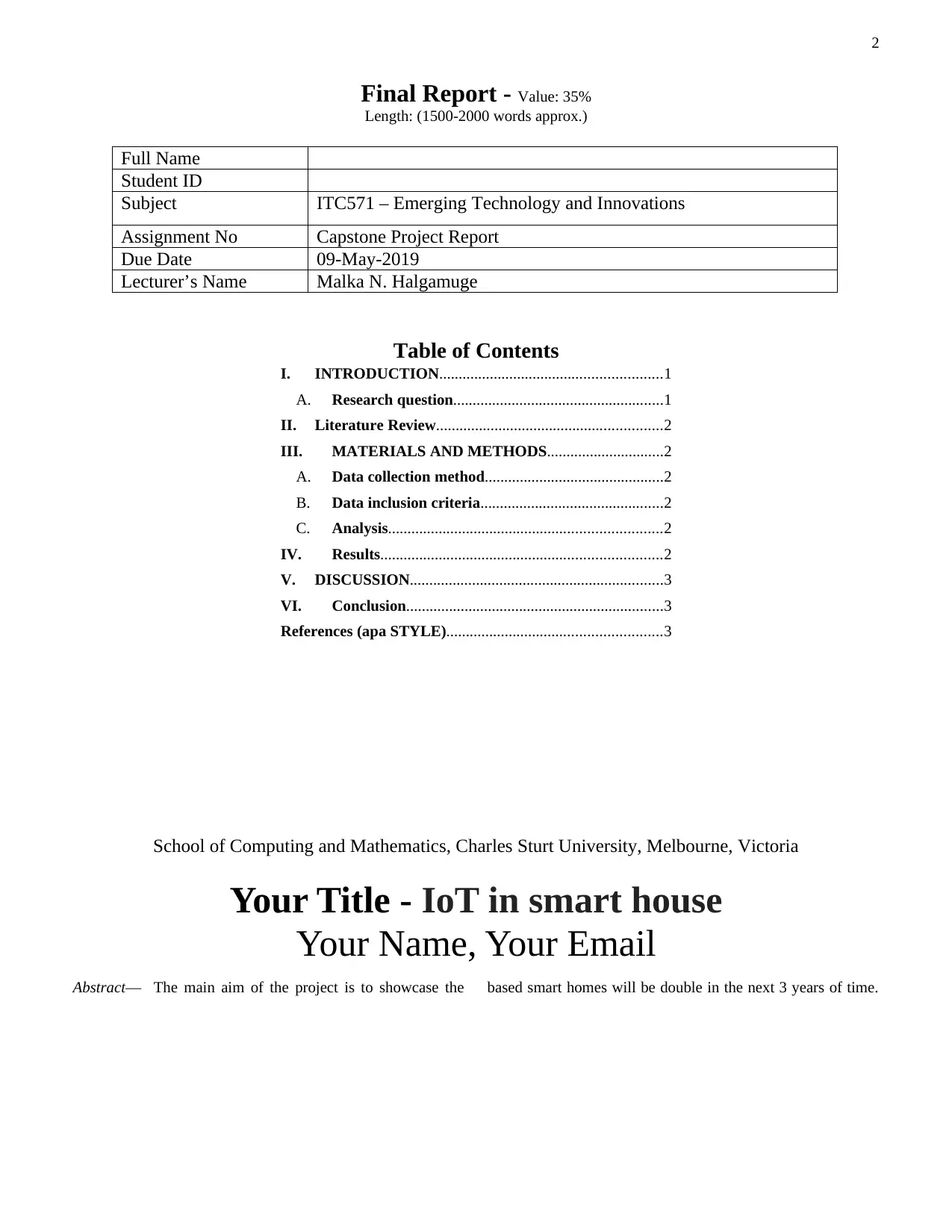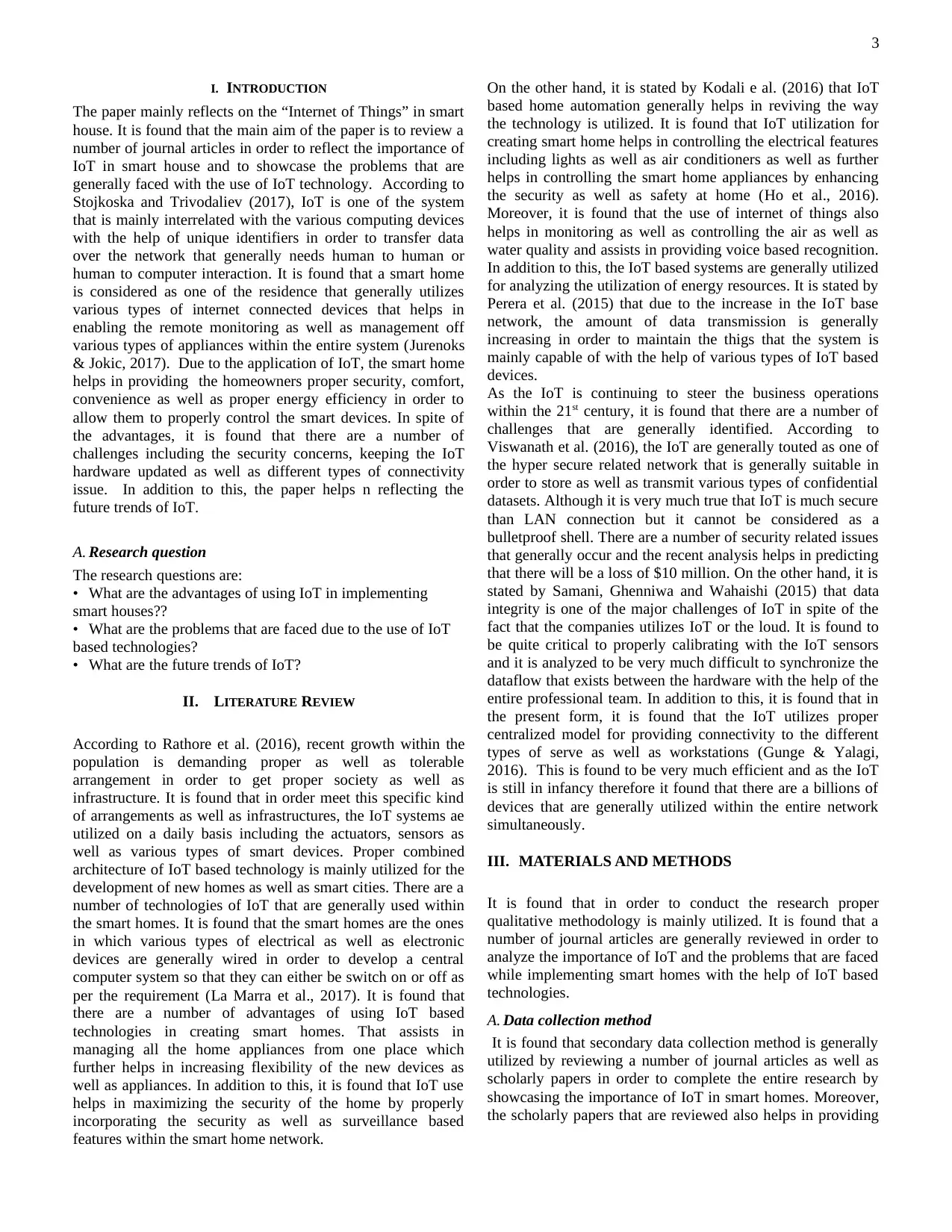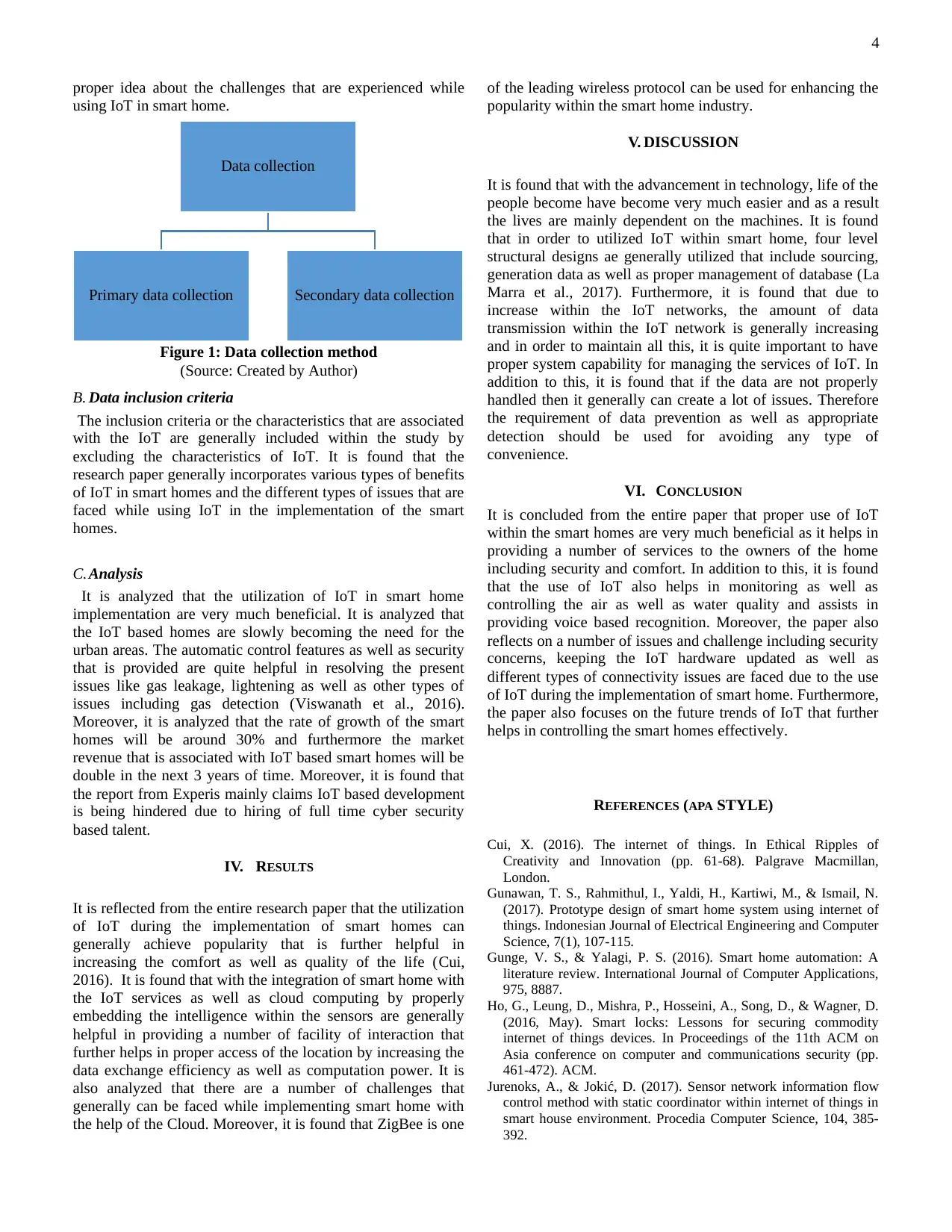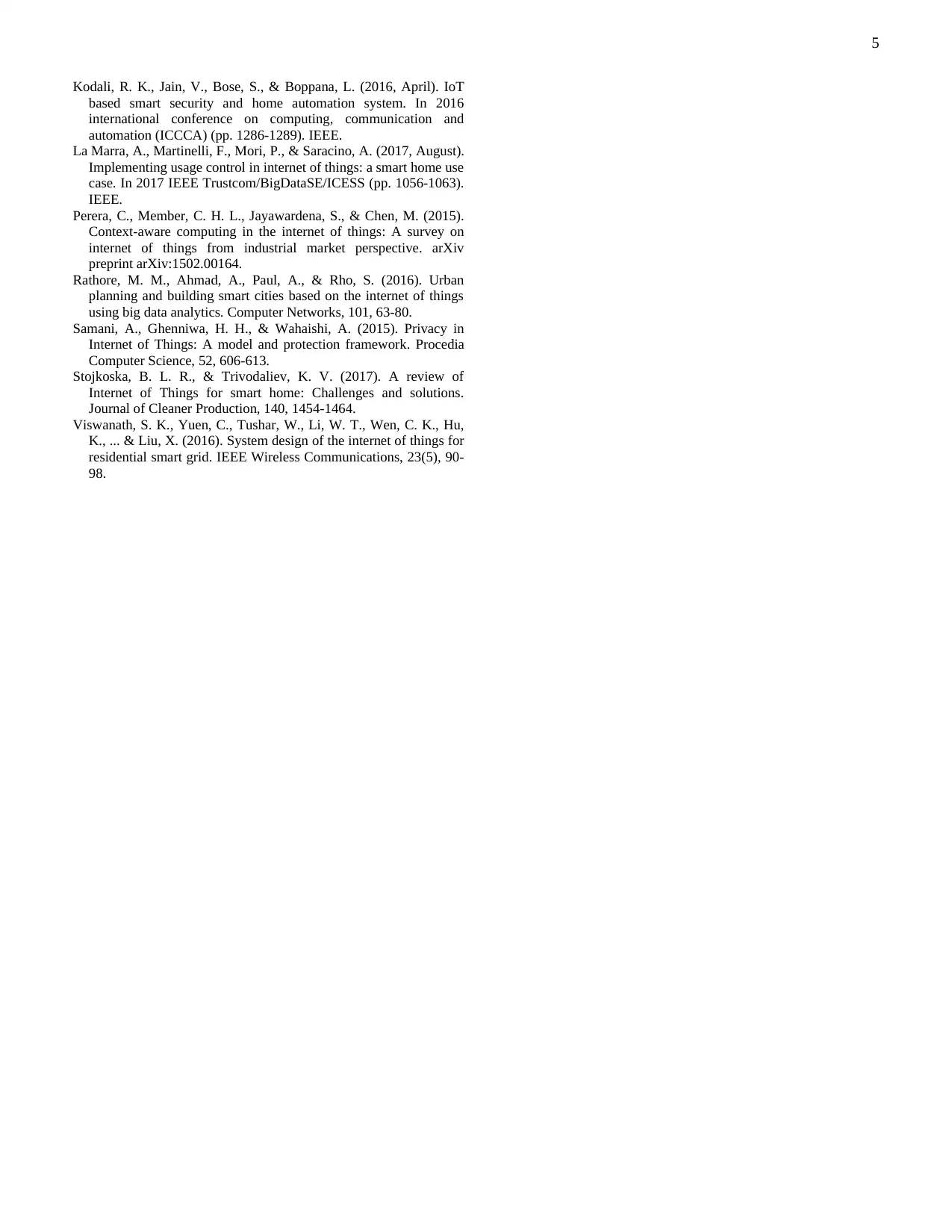ITC571 Capstone Project Report: IoT in Smart Home Systems
VerifiedAdded on 2023/01/06
|5
|2598
|47
Report
AI Summary
This report, a capstone project for ITC571 at Charles Sturt University, investigates the application of the Internet of Things (IoT) in smart homes. The research examines the advantages of IoT, such as increased security, convenience, and energy efficiency, while also addressing the challenges, including security concerns, data integrity issues, and connectivity problems. The study employs a qualitative methodology, reviewing journal articles to analyze the impact of IoT on smart home implementation. The findings highlight the growing popularity of IoT in urban areas, with a focus on its potential for automated control and enhanced security features. The report also discusses future trends, including the increasing amount of data transmission within IoT networks and the need for robust data management. Ultimately, the research concludes that the use of IoT in smart homes is beneficial, offering improved services and a higher quality of life for homeowners. The report includes sections on the research question, literature review, materials and methods, results, discussion, and conclusion, along with a list of references in APA style.

1
1
Paraphrase This Document
Need a fresh take? Get an instant paraphrase of this document with our AI Paraphraser

Table of Contents
I. INTRODUCTION.........................................................1
A. Research question......................................................1
II. Literature Review..........................................................2
III. MATERIALS AND METHODS..............................2
A. Data collection method..............................................2
B. Data inclusion criteria...............................................2
C. Analysis......................................................................2
IV. Results........................................................................2
V. DISCUSSION.................................................................3
VI. Conclusion..................................................................3
References (apa STYLE).......................................................3
Abstract— The main aim of the project is to showcase the based smart homes will be double in the next 3 years of time.
Final Report - Value: 35%
Length: (1500-2000 words approx.)
Full Name
Student ID
Subject ITC571 – Emerging Technology and Innovations
Assignment No Capstone Project Report
Due Date 09-May-2019
Lecturer’s Name Malka N. Halgamuge
Your Title - IoT in smart house
Your Name, Your Email
School of Computing and Mathematics, Charles Sturt University, Melbourne, Victoria
2
I. INTRODUCTION.........................................................1
A. Research question......................................................1
II. Literature Review..........................................................2
III. MATERIALS AND METHODS..............................2
A. Data collection method..............................................2
B. Data inclusion criteria...............................................2
C. Analysis......................................................................2
IV. Results........................................................................2
V. DISCUSSION.................................................................3
VI. Conclusion..................................................................3
References (apa STYLE).......................................................3
Abstract— The main aim of the project is to showcase the based smart homes will be double in the next 3 years of time.
Final Report - Value: 35%
Length: (1500-2000 words approx.)
Full Name
Student ID
Subject ITC571 – Emerging Technology and Innovations
Assignment No Capstone Project Report
Due Date 09-May-2019
Lecturer’s Name Malka N. Halgamuge
Your Title - IoT in smart house
Your Name, Your Email
School of Computing and Mathematics, Charles Sturt University, Melbourne, Victoria
2

I. INTRODUCTION
The paper mainly reflects on the “Internet of Things” in smart
house. It is found that the main aim of the paper is to review a
number of journal articles in order to reflect the importance of
IoT in smart house and to showcase the problems that are
generally faced with the use of IoT technology. According to
Stojkoska and Trivodaliev (2017), IoT is one of the system
that is mainly interrelated with the various computing devices
with the help of unique identifiers in order to transfer data
over the network that generally needs human to human or
human to computer interaction. It is found that a smart home
is considered as one of the residence that generally utilizes
various types of internet connected devices that helps in
enabling the remote monitoring as well as management off
various types of appliances within the entire system (Jurenoks
& Jokic, 2017). Due to the application of IoT, the smart home
helps in providing the homeowners proper security, comfort,
convenience as well as proper energy efficiency in order to
allow them to properly control the smart devices. In spite of
the advantages, it is found that there are a number of
challenges including the security concerns, keeping the IoT
hardware updated as well as different types of connectivity
issue. In addition to this, the paper helps n reflecting the
future trends of IoT.
A. Research question
The research questions are:
• What are the advantages of using IoT in implementing
smart houses??
• What are the problems that are faced due to the use of IoT
based technologies?
• What are the future trends of IoT?
II. LITERATURE REVIEW
According to Rathore et al. (2016), recent growth within the
population is demanding proper as well as tolerable
arrangement in order to get proper society as well as
infrastructure. It is found that in order meet this specific kind
of arrangements as well as infrastructures, the IoT systems ae
utilized on a daily basis including the actuators, sensors as
well as various types of smart devices. Proper combined
architecture of IoT based technology is mainly utilized for the
development of new homes as well as smart cities. There are a
number of technologies of IoT that are generally used within
the smart homes. It is found that the smart homes are the ones
in which various types of electrical as well as electronic
devices are generally wired in order to develop a central
computer system so that they can either be switch on or off as
per the requirement (La Marra et al., 2017). It is found that
there are a number of advantages of using IoT based
technologies in creating smart homes. That assists in
managing all the home appliances from one place which
further helps in increasing flexibility of the new devices as
well as appliances. In addition to this, it is found that IoT use
helps in maximizing the security of the home by properly
incorporating the security as well as surveillance based
features within the smart home network.
On the other hand, it is stated by Kodali e al. (2016) that IoT
based home automation generally helps in reviving the way
the technology is utilized. It is found that IoT utilization for
creating smart home helps in controlling the electrical features
including lights as well as air conditioners as well as further
helps in controlling the smart home appliances by enhancing
the security as well as safety at home (Ho et al., 2016).
Moreover, it is found that the use of internet of things also
helps in monitoring as well as controlling the air as well as
water quality and assists in providing voice based recognition.
In addition to this, the IoT based systems are generally utilized
for analyzing the utilization of energy resources. It is stated by
Perera et al. (2015) that due to the increase in the IoT base
network, the amount of data transmission is generally
increasing in order to maintain the thigs that the system is
mainly capable of with the help of various types of IoT based
devices.
As the IoT is continuing to steer the business operations
within the 21st century, it is found that there are a number of
challenges that are generally identified. According to
Viswanath et al. (2016), the IoT are generally touted as one of
the hyper secure related network that is generally suitable in
order to store as well as transmit various types of confidential
datasets. Although it is very much true that IoT is much secure
than LAN connection but it cannot be considered as a
bulletproof shell. There are a number of security related issues
that generally occur and the recent analysis helps in predicting
that there will be a loss of $10 million. On the other hand, it is
stated by Samani, Ghenniwa and Wahaishi (2015) that data
integrity is one of the major challenges of IoT in spite of the
fact that the companies utilizes IoT or the loud. It is found to
be quite critical to properly calibrating with the IoT sensors
and it is analyzed to be very much difficult to synchronize the
dataflow that exists between the hardware with the help of the
entire professional team. In addition to this, it is found that in
the present form, it is found that the IoT utilizes proper
centralized model for providing connectivity to the different
types of serve as well as workstations (Gunge & Yalagi,
2016). This is found to be very much efficient and as the IoT
is still in infancy therefore it found that there are a billions of
devices that are generally utilized within the entire network
simultaneously.
III. MATERIALS AND METHODS
It is found that in order to conduct the research proper
qualitative methodology is mainly utilized. It is found that a
number of journal articles are generally reviewed in order to
analyze the importance of IoT and the problems that are faced
while implementing smart homes with the help of IoT based
technologies.
A. Data collection method
It is found that secondary data collection method is generally
utilized by reviewing a number of journal articles as well as
scholarly papers in order to complete the entire research by
showcasing the importance of IoT in smart homes. Moreover,
the scholarly papers that are reviewed also helps in providing
3
The paper mainly reflects on the “Internet of Things” in smart
house. It is found that the main aim of the paper is to review a
number of journal articles in order to reflect the importance of
IoT in smart house and to showcase the problems that are
generally faced with the use of IoT technology. According to
Stojkoska and Trivodaliev (2017), IoT is one of the system
that is mainly interrelated with the various computing devices
with the help of unique identifiers in order to transfer data
over the network that generally needs human to human or
human to computer interaction. It is found that a smart home
is considered as one of the residence that generally utilizes
various types of internet connected devices that helps in
enabling the remote monitoring as well as management off
various types of appliances within the entire system (Jurenoks
& Jokic, 2017). Due to the application of IoT, the smart home
helps in providing the homeowners proper security, comfort,
convenience as well as proper energy efficiency in order to
allow them to properly control the smart devices. In spite of
the advantages, it is found that there are a number of
challenges including the security concerns, keeping the IoT
hardware updated as well as different types of connectivity
issue. In addition to this, the paper helps n reflecting the
future trends of IoT.
A. Research question
The research questions are:
• What are the advantages of using IoT in implementing
smart houses??
• What are the problems that are faced due to the use of IoT
based technologies?
• What are the future trends of IoT?
II. LITERATURE REVIEW
According to Rathore et al. (2016), recent growth within the
population is demanding proper as well as tolerable
arrangement in order to get proper society as well as
infrastructure. It is found that in order meet this specific kind
of arrangements as well as infrastructures, the IoT systems ae
utilized on a daily basis including the actuators, sensors as
well as various types of smart devices. Proper combined
architecture of IoT based technology is mainly utilized for the
development of new homes as well as smart cities. There are a
number of technologies of IoT that are generally used within
the smart homes. It is found that the smart homes are the ones
in which various types of electrical as well as electronic
devices are generally wired in order to develop a central
computer system so that they can either be switch on or off as
per the requirement (La Marra et al., 2017). It is found that
there are a number of advantages of using IoT based
technologies in creating smart homes. That assists in
managing all the home appliances from one place which
further helps in increasing flexibility of the new devices as
well as appliances. In addition to this, it is found that IoT use
helps in maximizing the security of the home by properly
incorporating the security as well as surveillance based
features within the smart home network.
On the other hand, it is stated by Kodali e al. (2016) that IoT
based home automation generally helps in reviving the way
the technology is utilized. It is found that IoT utilization for
creating smart home helps in controlling the electrical features
including lights as well as air conditioners as well as further
helps in controlling the smart home appliances by enhancing
the security as well as safety at home (Ho et al., 2016).
Moreover, it is found that the use of internet of things also
helps in monitoring as well as controlling the air as well as
water quality and assists in providing voice based recognition.
In addition to this, the IoT based systems are generally utilized
for analyzing the utilization of energy resources. It is stated by
Perera et al. (2015) that due to the increase in the IoT base
network, the amount of data transmission is generally
increasing in order to maintain the thigs that the system is
mainly capable of with the help of various types of IoT based
devices.
As the IoT is continuing to steer the business operations
within the 21st century, it is found that there are a number of
challenges that are generally identified. According to
Viswanath et al. (2016), the IoT are generally touted as one of
the hyper secure related network that is generally suitable in
order to store as well as transmit various types of confidential
datasets. Although it is very much true that IoT is much secure
than LAN connection but it cannot be considered as a
bulletproof shell. There are a number of security related issues
that generally occur and the recent analysis helps in predicting
that there will be a loss of $10 million. On the other hand, it is
stated by Samani, Ghenniwa and Wahaishi (2015) that data
integrity is one of the major challenges of IoT in spite of the
fact that the companies utilizes IoT or the loud. It is found to
be quite critical to properly calibrating with the IoT sensors
and it is analyzed to be very much difficult to synchronize the
dataflow that exists between the hardware with the help of the
entire professional team. In addition to this, it is found that in
the present form, it is found that the IoT utilizes proper
centralized model for providing connectivity to the different
types of serve as well as workstations (Gunge & Yalagi,
2016). This is found to be very much efficient and as the IoT
is still in infancy therefore it found that there are a billions of
devices that are generally utilized within the entire network
simultaneously.
III. MATERIALS AND METHODS
It is found that in order to conduct the research proper
qualitative methodology is mainly utilized. It is found that a
number of journal articles are generally reviewed in order to
analyze the importance of IoT and the problems that are faced
while implementing smart homes with the help of IoT based
technologies.
A. Data collection method
It is found that secondary data collection method is generally
utilized by reviewing a number of journal articles as well as
scholarly papers in order to complete the entire research by
showcasing the importance of IoT in smart homes. Moreover,
the scholarly papers that are reviewed also helps in providing
3
⊘ This is a preview!⊘
Do you want full access?
Subscribe today to unlock all pages.

Trusted by 1+ million students worldwide

proper idea about the challenges that are experienced while
using IoT in smart home.
Figure 1: Data collection method
(Source: Created by Author)
B. Data inclusion criteria
The inclusion criteria or the characteristics that are associated
with the IoT are generally included within the study by
excluding the characteristics of IoT. It is found that the
research paper generally incorporates various types of benefits
of IoT in smart homes and the different types of issues that are
faced while using IoT in the implementation of the smart
homes.
C.Analysis
It is analyzed that the utilization of IoT in smart home
implementation are very much beneficial. It is analyzed that
the IoT based homes are slowly becoming the need for the
urban areas. The automatic control features as well as security
that is provided are quite helpful in resolving the present
issues like gas leakage, lightening as well as other types of
issues including gas detection (Viswanath et al., 2016).
Moreover, it is analyzed that the rate of growth of the smart
homes will be around 30% and furthermore the market
revenue that is associated with IoT based smart homes will be
double in the next 3 years of time. Moreover, it is found that
the report from Experis mainly claims IoT based development
is being hindered due to hiring of full time cyber security
based talent.
IV. RESULTS
It is reflected from the entire research paper that the utilization
of IoT during the implementation of smart homes can
generally achieve popularity that is further helpful in
increasing the comfort as well as quality of the life (Cui,
2016). It is found that with the integration of smart home with
the IoT services as well as cloud computing by properly
embedding the intelligence within the sensors are generally
helpful in providing a number of facility of interaction that
further helps in proper access of the location by increasing the
data exchange efficiency as well as computation power. It is
also analyzed that there are a number of challenges that
generally can be faced while implementing smart home with
the help of the Cloud. Moreover, it is found that ZigBee is one
of the leading wireless protocol can be used for enhancing the
popularity within the smart home industry.
V. DISCUSSION
It is found that with the advancement in technology, life of the
people become have become very much easier and as a result
the lives are mainly dependent on the machines. It is found
that in order to utilized IoT within smart home, four level
structural designs ae generally utilized that include sourcing,
generation data as well as proper management of database (La
Marra et al., 2017). Furthermore, it is found that due to
increase within the IoT networks, the amount of data
transmission within the IoT network is generally increasing
and in order to maintain all this, it is quite important to have
proper system capability for managing the services of IoT. In
addition to this, it is found that if the data are not properly
handled then it generally can create a lot of issues. Therefore
the requirement of data prevention as well as appropriate
detection should be used for avoiding any type of
convenience.
VI. CONCLUSION
It is concluded from the entire paper that proper use of IoT
within the smart homes are very much beneficial as it helps in
providing a number of services to the owners of the home
including security and comfort. In addition to this, it is found
that the use of IoT also helps in monitoring as well as
controlling the air as well as water quality and assists in
providing voice based recognition. Moreover, the paper also
reflects on a number of issues and challenge including security
concerns, keeping the IoT hardware updated as well as
different types of connectivity issues are faced due to the use
of IoT during the implementation of smart home. Furthermore,
the paper also focuses on the future trends of IoT that further
helps in controlling the smart homes effectively.
REFERENCES (APA STYLE)
Cui, X. (2016). The internet of things. In Ethical Ripples of
Creativity and Innovation (pp. 61-68). Palgrave Macmillan,
London.
Gunawan, T. S., Rahmithul, I., Yaldi, H., Kartiwi, M., & Ismail, N.
(2017). Prototype design of smart home system using internet of
things. Indonesian Journal of Electrical Engineering and Computer
Science, 7(1), 107-115.
Gunge, V. S., & Yalagi, P. S. (2016). Smart home automation: A
literature review. International Journal of Computer Applications,
975, 8887.
Ho, G., Leung, D., Mishra, P., Hosseini, A., Song, D., & Wagner, D.
(2016, May). Smart locks: Lessons for securing commodity
internet of things devices. In Proceedings of the 11th ACM on
Asia conference on computer and communications security (pp.
461-472). ACM.
Jurenoks, A., & Jokić, D. (2017). Sensor network information flow
control method with static coordinator within internet of things in
smart house environment. Procedia Computer Science, 104, 385-
392.
Data collection
Primary data collection Secondary data collection
4
using IoT in smart home.
Figure 1: Data collection method
(Source: Created by Author)
B. Data inclusion criteria
The inclusion criteria or the characteristics that are associated
with the IoT are generally included within the study by
excluding the characteristics of IoT. It is found that the
research paper generally incorporates various types of benefits
of IoT in smart homes and the different types of issues that are
faced while using IoT in the implementation of the smart
homes.
C.Analysis
It is analyzed that the utilization of IoT in smart home
implementation are very much beneficial. It is analyzed that
the IoT based homes are slowly becoming the need for the
urban areas. The automatic control features as well as security
that is provided are quite helpful in resolving the present
issues like gas leakage, lightening as well as other types of
issues including gas detection (Viswanath et al., 2016).
Moreover, it is analyzed that the rate of growth of the smart
homes will be around 30% and furthermore the market
revenue that is associated with IoT based smart homes will be
double in the next 3 years of time. Moreover, it is found that
the report from Experis mainly claims IoT based development
is being hindered due to hiring of full time cyber security
based talent.
IV. RESULTS
It is reflected from the entire research paper that the utilization
of IoT during the implementation of smart homes can
generally achieve popularity that is further helpful in
increasing the comfort as well as quality of the life (Cui,
2016). It is found that with the integration of smart home with
the IoT services as well as cloud computing by properly
embedding the intelligence within the sensors are generally
helpful in providing a number of facility of interaction that
further helps in proper access of the location by increasing the
data exchange efficiency as well as computation power. It is
also analyzed that there are a number of challenges that
generally can be faced while implementing smart home with
the help of the Cloud. Moreover, it is found that ZigBee is one
of the leading wireless protocol can be used for enhancing the
popularity within the smart home industry.
V. DISCUSSION
It is found that with the advancement in technology, life of the
people become have become very much easier and as a result
the lives are mainly dependent on the machines. It is found
that in order to utilized IoT within smart home, four level
structural designs ae generally utilized that include sourcing,
generation data as well as proper management of database (La
Marra et al., 2017). Furthermore, it is found that due to
increase within the IoT networks, the amount of data
transmission within the IoT network is generally increasing
and in order to maintain all this, it is quite important to have
proper system capability for managing the services of IoT. In
addition to this, it is found that if the data are not properly
handled then it generally can create a lot of issues. Therefore
the requirement of data prevention as well as appropriate
detection should be used for avoiding any type of
convenience.
VI. CONCLUSION
It is concluded from the entire paper that proper use of IoT
within the smart homes are very much beneficial as it helps in
providing a number of services to the owners of the home
including security and comfort. In addition to this, it is found
that the use of IoT also helps in monitoring as well as
controlling the air as well as water quality and assists in
providing voice based recognition. Moreover, the paper also
reflects on a number of issues and challenge including security
concerns, keeping the IoT hardware updated as well as
different types of connectivity issues are faced due to the use
of IoT during the implementation of smart home. Furthermore,
the paper also focuses on the future trends of IoT that further
helps in controlling the smart homes effectively.
REFERENCES (APA STYLE)
Cui, X. (2016). The internet of things. In Ethical Ripples of
Creativity and Innovation (pp. 61-68). Palgrave Macmillan,
London.
Gunawan, T. S., Rahmithul, I., Yaldi, H., Kartiwi, M., & Ismail, N.
(2017). Prototype design of smart home system using internet of
things. Indonesian Journal of Electrical Engineering and Computer
Science, 7(1), 107-115.
Gunge, V. S., & Yalagi, P. S. (2016). Smart home automation: A
literature review. International Journal of Computer Applications,
975, 8887.
Ho, G., Leung, D., Mishra, P., Hosseini, A., Song, D., & Wagner, D.
(2016, May). Smart locks: Lessons for securing commodity
internet of things devices. In Proceedings of the 11th ACM on
Asia conference on computer and communications security (pp.
461-472). ACM.
Jurenoks, A., & Jokić, D. (2017). Sensor network information flow
control method with static coordinator within internet of things in
smart house environment. Procedia Computer Science, 104, 385-
392.
Data collection
Primary data collection Secondary data collection
4
Paraphrase This Document
Need a fresh take? Get an instant paraphrase of this document with our AI Paraphraser

Kodali, R. K., Jain, V., Bose, S., & Boppana, L. (2016, April). IoT
based smart security and home automation system. In 2016
international conference on computing, communication and
automation (ICCCA) (pp. 1286-1289). IEEE.
La Marra, A., Martinelli, F., Mori, P., & Saracino, A. (2017, August).
Implementing usage control in internet of things: a smart home use
case. In 2017 IEEE Trustcom/BigDataSE/ICESS (pp. 1056-1063).
IEEE.
Perera, C., Member, C. H. L., Jayawardena, S., & Chen, M. (2015).
Context-aware computing in the internet of things: A survey on
internet of things from industrial market perspective. arXiv
preprint arXiv:1502.00164.
Rathore, M. M., Ahmad, A., Paul, A., & Rho, S. (2016). Urban
planning and building smart cities based on the internet of things
using big data analytics. Computer Networks, 101, 63-80.
Samani, A., Ghenniwa, H. H., & Wahaishi, A. (2015). Privacy in
Internet of Things: A model and protection framework. Procedia
Computer Science, 52, 606-613.
Stojkoska, B. L. R., & Trivodaliev, K. V. (2017). A review of
Internet of Things for smart home: Challenges and solutions.
Journal of Cleaner Production, 140, 1454-1464.
Viswanath, S. K., Yuen, C., Tushar, W., Li, W. T., Wen, C. K., Hu,
K., ... & Liu, X. (2016). System design of the internet of things for
residential smart grid. IEEE Wireless Communications, 23(5), 90-
98.
5
based smart security and home automation system. In 2016
international conference on computing, communication and
automation (ICCCA) (pp. 1286-1289). IEEE.
La Marra, A., Martinelli, F., Mori, P., & Saracino, A. (2017, August).
Implementing usage control in internet of things: a smart home use
case. In 2017 IEEE Trustcom/BigDataSE/ICESS (pp. 1056-1063).
IEEE.
Perera, C., Member, C. H. L., Jayawardena, S., & Chen, M. (2015).
Context-aware computing in the internet of things: A survey on
internet of things from industrial market perspective. arXiv
preprint arXiv:1502.00164.
Rathore, M. M., Ahmad, A., Paul, A., & Rho, S. (2016). Urban
planning and building smart cities based on the internet of things
using big data analytics. Computer Networks, 101, 63-80.
Samani, A., Ghenniwa, H. H., & Wahaishi, A. (2015). Privacy in
Internet of Things: A model and protection framework. Procedia
Computer Science, 52, 606-613.
Stojkoska, B. L. R., & Trivodaliev, K. V. (2017). A review of
Internet of Things for smart home: Challenges and solutions.
Journal of Cleaner Production, 140, 1454-1464.
Viswanath, S. K., Yuen, C., Tushar, W., Li, W. T., Wen, C. K., Hu,
K., ... & Liu, X. (2016). System design of the internet of things for
residential smart grid. IEEE Wireless Communications, 23(5), 90-
98.
5
1 out of 5
Related Documents
Your All-in-One AI-Powered Toolkit for Academic Success.
+13062052269
info@desklib.com
Available 24*7 on WhatsApp / Email
![[object Object]](/_next/static/media/star-bottom.7253800d.svg)
Unlock your academic potential
Copyright © 2020–2025 A2Z Services. All Rights Reserved. Developed and managed by ZUCOL.





